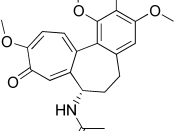Colchicine is a highly poisonous water-soluble alkaloid found in plants of the genus Colchicum (autumn crocus, meadow saffron) with the chemical formula C22H25NO6. The chemical name or common name for colchicine is (S) N-(5,6,7,9-tetrahydro- 1,2,3, IO-tetramethoxy-9-oxobenzo [alpha] heptaien-7-yl) acetamide. The molecular weight of it is 399.2 grams.
Colchicine has 4 isomers,each pair has either R or S configuration.(-)-(aS,7S)-Colchicine is the natural isomer which can interconvert between aR and aS
* C22H25NO6
* molecular weight is 399.4426
* melting point is 142 degrees Celsius
* water solubility is less than 10/g mL at 21 degrees Celsius
* pale yellow to greenish crystalline powder
* photosenstive
* slowly hyrdolyzes in acidic solution
* First used over 2000 years ago
* derived form preparations of Colchicum autumnale
* First described by Padanius Dioscordes (AD 54-68), a Greek surgeon, in De Materia Medica
* currently produced locally by Sigma
Uses:
* Treatment of gout
* Treatment of Familial Mediterranean Fever
* minimally effective chemotherapy agent
* research use as an antimitotic agent
* new uses being explored
- chronic hepatitis B and cirrhosis
- Sweet's syndrome
- pediatric pericarditis
- constipation
Symptoms:
* Nausea
* diarrhea
* pancytopenia
* alopecia
* weakness
* respiratory distress
- potentially fatal
Is divided into 3 phases:
* Stage I is the G.I.
Phase
- occurs within hours of ingestion
* Stage II is the multi-phase stage
- cardiovascular insufficiency
- respiratory insufficiency
- metabolic effects
- neuromuscular effects
- hematologic effects
* Stage III is the recovery phase:
- occurs 7 to 10 days after ingestion
- marked by alopecia
- rebound leukocytosis
Mechanism of toxicity:
* Metabolized in the liver
- facilitated by cytochrome P450
- undergoes deacetylation and hydrolysis
- converted to oxydicolchicine
Recirculated in Liver:
* Significant amount absorbed in the digestive tract...



Well..
No real enthusiasm in this essay, it mearly stated things. If this was an AP essay for chemistry that would be fine.
0 out of 0 people found this comment useful.